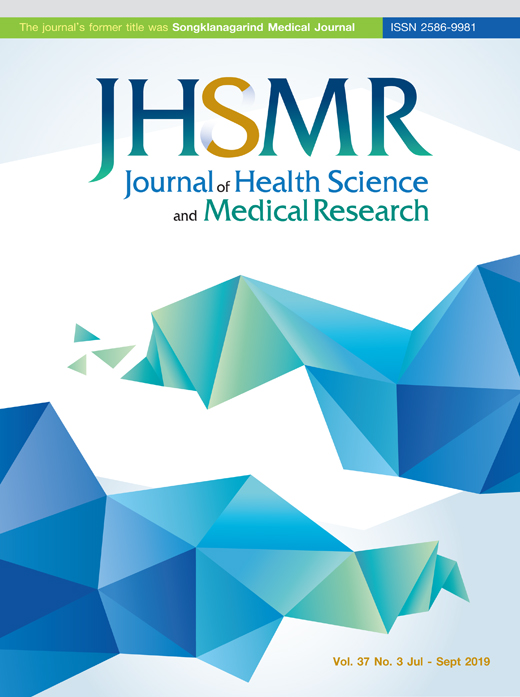Effectiveness of a Plai Oil Prepared by Thai Traditional Medicine Process in the Treatment of Myofascial Pain Syndrome: A Randomized Placebo Controlled Trial
Effectiveness of Plai oil in Myofascial Pain Syndrome
DOI:
https://doi.org/10.31584/jhsmr.201954Keywords:
myofascial pain, Plai oil, Zingiber montanumAbstract
Objective: To evaluate the effectiveness of Plai oil for treating myofascial pain syndrome.
Material and Methods: One hundred and fourteen volunteers with muscle pain from myofascial pain syndrome participated in the study and had Plai oil, placebo oil and diclofenac gel applied to their shoulder and neck for 6 days. Clinical evaluation was determined using visual analogue scales, pressure threshold and cervical range of motion of neck flexion and neck extension measurements.
Results: The results showed that the visual analogue scales of the 3 groups were significantly different from the baseline. The pressure threshold also increased significantly from the baseline (3.87±1.36) in the volunteers who applied Plai oil (4.42±1.34) and those who applied diclofenac gel (4.35±1.06). However, the results of treatment and placebo groups at the last follow-up were not significantly different. Interestingly, it was observed that Plai oil and placebo oil significantly increased the angle of neck flexion and extension within 3 days of application. Muscle pain treatment with Plai oil resulted in a good outcome that was no different to the outcome of applying the diclofenac gel and placebo.
Conclusion: It was demonstrated that Plai oil is as effective for relieving myofascial pain as 1.0% diclofenac gel.
The interpreted results of muscle pain are not fully clarified due to placebo effect and other influencing parameters. However, Plai oil also decreased muscle tension and improved the restricted range of motion. We can recommend that Plai oil can be used as an alternative topical application for muscle pain treatment.
References
2. Hanpithakpong W. Studies on safety and efficacy of Phlai gel. Bangkok: Graduate School, Mahidol University; 1999.
3. Suksaeree J, Charoenchai L, Pichayakorn W, Boonme P. HPLC method development and validation of (E)-4-(3,4-dimethoxyphenyl)-but-3-en-1-ol in Zingiber cassumunar Roxb. from Thai herbal compress ball. Int J Pharm Pharm Sci 2013;3:115-7.
4. Lateh L. Development of extraction method for phenylbutanoids from Zingiber cassumunar Roxb. Songkhla: Faculty of Pharmaceutical Sciences, Prince of Songkla University; 2013.
5. Department of Medical Sciences MoPH. Thai herbal pharmacopoeia. Vol 1. Bangkok: Prachachon; 2007.
6. Suksaeree J, Monton C, Charoenchai L, Madaka F, Chusut T. Determination of (E)-4-(3’,4’-Dimethoxyphenyl)-But-3-
en-1-ol Content in Zingiber cassumunar Roxb. (Plai) Patches. Int J Pharm Pharm Sci 2014;6:434-6.
7. Han AR, Kim MS, Jeong YH, Lee SK, Soe EK. Cyclooxygenase-2 inhibitory phenylbutenoids from the rhizomes of
Zingiber cassumunar. Chem Pharm Bull 2005;53:1466-8.
8. Jeenapongsa R, Yoovathaworn K, Sriwatanakul KM, Pongprayoon U, Sriwatanakul K. Anti-inflammatory activity of
(E)-1-(3,4-dimethoxyphenyl) butadiene from Zingiber cassumunar Roxb. J Ethnopharmacol 2003;87:143-8.
9. Panthong A, Kanjanapothi D, Niwatananant W, Tuntiwachwuttikul P, Reutrakul V. Anti-inflammatory activity of compound D {(E)-4-(3′,4′-dimethoxyphenyl)but-3-en-2-ol} isolated from Zingiber cassumunar Roxb. Phytomedicine 1997;4:207-12.
10. Loupattarakasem W, Kowsuwon W, Laupattarakasem P, Eungpinitpong W. Efficacy of Zingiber cassumunar ROXB.
(Plygesal) in the treatment of ankle sprain. Srinagarind Med J 1993;8:159-64.
11. Manimmanakorn N, Manimmanakorn A, Boobphachart D, Thuwakum W, Laupattarakasem W, Hamlin MJ. Effects of
Zingiber cassumunar (Plai cream) in the treatment of delayed onset muscle soreness. J Integr Med 2016;14:114-20.
12. Health MoP. National list of essential medicine 2016. In: Drugs DoP, editor. National list of essential medicine 2016.
Nonthaburi: Ministry of Public Health; 2016;p.269.
13. Park G, Kim CW, Park SB, Kim MJ, Jang SH. Reliability and usefulness of the pressure pain threshold measurement in patients with myofascial pain. Ann Rehabil Med 2011;35:412-7.
14. Manimmanakorn N, Manimmanakorn A, Boukamtuem T. Reliability and validity of simple algometer. J Thai Rehabil
Med 2005;15:79-87.
15. Srimal RC, Dhawan BN. Pharmacology of diferuloyl methane (curcumin), a non-steroidal anti-inflammatory agent. J Pharm Pharmacol 1973;25:447-52.
16. Pongprayoon U, Soontornsaratune P, Jarikasem S, Sematong T, Wasuwat S, Claeson P. Topical antiinflammatory activity of the major lipophilic constituents of the rhizome of Zingiber cassumunar. Part I: the essential oil. Phytomedicine 1997;3:319-22.
17. Higashi Y, Kiuchi T, Furuta K. Efficacy and safety profile of a topical methyl salicylate and menthol patch in adult patients with mild to moderate muscle strain: a randomized, doubleblind, parallel-group, placebo-controlled, multicenter study. Clin Ther 2010;32:34-43.
18. Zhang D, Liu R, Sun L, Huang C, Wang C, Zhang DM, et al. Anti-inflammatory activity of methyl salicylate glycosides isolated from Gaultheria yunnanensis (Franch.) Rehder. Molecules 2011;16:3875-84.
19. Fischer AA. Pressure threshold meter: its use for quantification of tender spots. Arch Phys Med Rehabil 1986;67:836-8.
20. Janpim K, Nualkaew S, Priprem A. Stability testing of a Plai extract. Paper presented at: Graduate Research Conference; 2012 Feb 16-17; Khonkaen. Khonkaen: Graduated School,Khonkaen University; 2012.
21. Finley JE. Physical medicine and rehabilitation for myofascial pain [homepage on the Internet]. New York: Medscape [cited 2015 Aug 12]. Available from: https://emedicine.medscape.com/article/313007-overview
22. Boonruab J, Niempoog S, Pattaraarchachai J, Palanuvej C, Ruangrungs N. Effectiveness of the court-type traditional
Thai massage versus topical diclofenac in treating patients with myofascial pain syndrome in the upper trapezius. Indian J Traditional Knowledge 2016;15:30-4.
23. Kong LJ, Zhan HS, Cheng YW, Yuan WA, Chen B, Fang M. Massage therapy for neck and shoulder pain: a systematic review and meta-analysis. Evid Based Complement Alternat Med 2013. doi: 10.1155/2013/613279.
24. Bervoets DC, Luijsterburg PAJ, Alessie JJN, Buijs MJ, Verhagen AP. Massage therapy has short-term benefits for people with common musculoskeletal disorders compared to no treatment: a systematic review. J Physiother 2015;61:106-16.
























